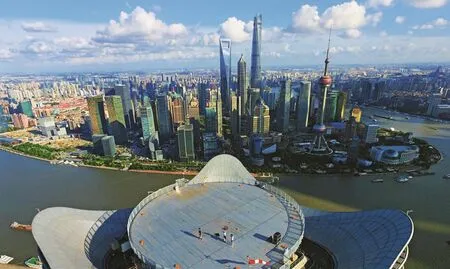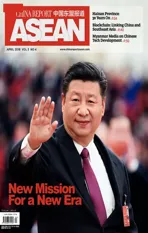Learning from China’s Development Experience
2018-04-14ByIvyGanadillo
By Ivy Ganadillo

An aerial view of modern Shanghai’s stunning skyline.
I recently found the chance to talk with a small business owner from Marikina City who is worried about the influx of Chinese goods coming into the Philippines. He is confident in the quality of Philippine products and knows we can compete in the world. However,in reality, many industries are dying,not only because of global competition but also due to problems and challenges related to knowledge transfer, financial capital, and meager Filipino domestic consumption. Interestingly, this situation makes him say, “We should learn from China.”
The year 1978 marked the beginning of reform and opening-up of the People’s Republic of China.Four decades have passed, and China is now the second largest economy in the world. The Philippines became an independent nation in 1946—71 years ago. But where are we now? For a long time after the WWII, the Philippines was a model of development and the second largest economy in Asia, but sadly it was not able to sustain its economic growth and was overtaken by countries like South Korea that learned from our country’s development model.
What can we learn from China’s rise and current development?
China’s experiences and lessons cannot be simply transferred and applied to other countries. But we can learn from their experiences and evaluate our own policies to try some of their more successful practices. China has still a long way to go to become a fully developed country and solve all of its domestic problems. It is battling poverty, corruption and many other socio-economic and political problems like many other countries. Despite this, however, China’s rise in a very short period has attracted the attention of the whole world.
To draw some lessons from the country’s development, I will focus the discussion on science and technology in education and the emergence of China’s special economic zones(SEZs).
The strength of a country is its people.The Filipino nation is composed of proud,hardworking, and bright people. Some scholars have argued that the decline of Phillippine development over the years was brought by failures to harness the education system to promote economic development and even national unity. The Philippines is still experimenting with its “K to 12 Program” to improve the skills of Filipino graduates feeding the country’s workforce. A huge budget appropriation is needed for this to make progress in this area because a number of private educational institutions have increased tuition and other fees to improve their facilities.
During the 19th Communist Party of China (CPC)National Congress last October, President Xi Jinping reiterated the education’s role and emphasized its function in fueling China’s domestic transformation by 2049. According to a report released by Xinhua News Agency, China spent US$565.6 billion on education in 2016, ranking it among the top 10 in the country’s broad spending categories. The country invests massively in education, especially in skills development. According to the World Economic Forum Report, China produced 4.7 million STEM (Science, Technology, Engineering,and Mathematics) graduates in 2016 and is predicted by the Economic Intelligence Unit to have the most STEM graduates in the world by 2030. China also continues to send more students abroad and continually improve its vocational education and training programs. China’s investment and unprecedented attention to talent and skills development are targeted in a timetable and part of the government’s national blueprint.
China’s investment in human resources has produced more Ph.D. graduates than the United Kingdom annually since 2002. Its scientific strength is demonstrated by numerous research and development (R&D) centers across the country including foreign-funded ones. They provide Chinese firms with R&D support in lowcost manufacturing and help develop more products for markets. China has been evolving from an imitator to an innovator as proven by the tech-products they are able to produce now. According to research, the four factors that drive China’s rise in science are: large population and human capital base, labor market favoring academic meritocracy, large diaspora of Chinese-origin scientists and a government willing to invest in science.
China has shown that education and skills development should not be treated as a means for an individual to escape from poverty but be part of grand objective and long-term development strategy of a country.
We have also seen how China learned from its history and how new government policies became more pragmatic as China opened its doors to the world and used Special Economic Zones (SEZs)to experiment and test its new policies. SEZs are geographical areas where special measures are implemented and when successful they become models for the other areas to follow.

Students in a carpentry class at a primary school in Shenyang,Liaoning Province. As a national pilot in creative education, the school offers “creative” classes specializing in 3D printing, model airplane, carpentry, circuitry and other sciences, aiming to combine public education with creativity development.

About the author:Ivy Ganadillo is a lecturer at the Chinese Studies Program of Ateneo de Manila University and board member of Philippine Association for Chinese Studies (PACS).
SEZs tested the market economy, bringing modern technologies and new management practices into China’s industrial parks and zones. According to 2014 data, China had six SEZs, 14 open coastal cities, four pilot free trade areas and five financial reform pilot areas. It is also home to 31 bonded areas, 114 national high-tech development parks, 164 national agricultural technology parks, 85 national eco-industrial parks, 55 national ecological civilization demonstration areas and 283 national modern agriculture demonstration
areas. The SEZs generated the country’s foreign direct investments (FDIs), numerous exports and millions of jobs. According to a World Bank report, Chinese SEZs have contributed 22% of China’s GDP, 45% of its FDI flows and 60% of exports. They are also estimated to have generated over 30 million jobs, increased the income of participating farmers by 30%and accelerated industrialization, agricultural modernization and urbanization. The success of China’s SEZs is attributed to top-down governmental support, research development and incubating local innovation. Of course, these significant contributions did not come without challenges.
Not everyone knows that the Philippines also has SEZs, which were established through “The Special Economic Zone Act of 1995.” As of November 2017,the country had a total of 379 economic zones.According to the latest report from the Philippine Economic Zone Authority (PEZA), a total of 300 new economic zones will be opened this year. Philippine SEZs face challenges as some assessments show that the costs of SEZs outweigh their benefits. They need to be strengthened to provide viable and sustainable contributions to national development.They should also be strategically located to align with affected communities. Some Philippine SEZs are controversial because of alleged agricultural land encroachment on small farm holders and ancestral domains of indigenous people.
The Philippines continues to institute new socioeconomic policies from Luzon to Mindanao. There are no exemptions to every law that our country enacts.We are also in the process of planning to amend our constitution and form of government. The big questions now are: Can we afford to overhaul and test all these policies across the country? What is the most pragmatic approach to institute big changes with tremendous impact? Can we possibly try policies on a smaller scale,and then polish and expand a version that works?
China’s economic growth and development was neither built overnight nor an easy process for the whole country. It is a product of thorough study and experimentation. The role of science and technology and SEZs are just a few examples of how China was able to change its path from a struggling nation to the next superpower of the world. It is important to carefully study its path of development, its success and the challenges it faces.
